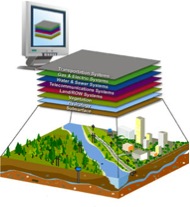by Melissa Brenes-Bastos, mbrenes@vt.edu
Demers (2009) defined Geographic Information Systems (GIS) as “a system designed to input, store, edit, retrieved, analyze, and output geographic data and information”. As all systems GIS is composed of integrated parts that allow it to perform correctly, these parts include: (1) computer hardware and software, (2) space and organization, (3) personnel and (4) data and information. (Demers, 2009)

Over 25 hundred years of geographic research and investigation, result on geographic information systems evolution, the first stages of GIS were focusing on exploration unknown lands, their inhabitants and phenomena’s, in other words the primary focus was discovering. (Demers, 2009) It was explain by Demers (2009) that the need of explain phenomena’s lead researcher to create an outcome of pattern explanations for different distributions, in the early 1960’s the Department of Forestry and Rural Development of Canada pursue a project to manage the territory of Canada, this was the first big scale project. With this project the first operational system ever built was created – Canada Geographic Information Systems-, this creation lead to more research and exploring which conduce to the actual GIS, as we know now a days. (Demers, 2009)
Grimshaw (1993) describe GIS for business purposes as an application or tool that support management decisions. According to Toppen & Wapenaar (1994) mention that every activity and process requires a different kind of GIS within each level of the organization, this correspond to: (1) Operational GIS applications; use GIS to monitor functionalities of goods for the retail, (2) Tactical application; provide information for decision making and (3) Combination of spatial data; information on market potential and competitors location.
Wood Product or Forest Product Industry has used GIS application to different proposes such as; Surveying and mapping wood residues (De Hoop et all, 1997), Planning the use of information technology in marketing (Toivonen, 1999), Consumer behavior in forest products (Anderson et all, 2005), Green advertising in forest sectors (Grillo, Tokarcsyk & Hansen, 2008), Availability of biomass residues for bioenergy production (Parhizkar & Smith, 2008), Forest cover changes (Kumar, 2011) to mention some.
Demers (2009) affirm that Geographic Information Systems is an exiting and glamorous field, which is expanding rapidly in opportunities for those who know the concepts and the technology.
References:
| Anderson R, Fell D, Smith R, Hansen E & Gomon S. (2005). Current Consumer Behavior Research in Forest Products. Forest Products Journal. Vol.55 No.1, PP. 21-27. |
| De Hoop, C., Kleit, S., Chang, S., Gazo, R. & Buchart, M. (1997) Survey and mapping of wood residu users and producers in Louisiana. Forest Products Journal. Vol. 47 No. 3, PP. 31-37. |
| Demers, M. (2009) Fundamentals of Geographic Information Systems. John Wiley & Sons, Inc. Fourth Edition.
|
| Grimshaw. D.J. (1993). GIS in commerce. In: Geographic information 1994, PP. 206-211. Association for Geographic information/ Taylor & Francis: London, UK. |
| Grillo, N., Tokarcyk, J. & Hansen, E. (2008) Green advertising developments in the U.S. forest sector: a follow-up. Forest Products Journal. Vol. 58 No. 5, PP.40 – 46 |
| Lawrence E. (2007). GIS and Collegues of Business: A curricular Exploration. Journal of Real Estate Literature. Vol.15 No.3. |
| Parhizkar, O & Smith, R. (2008). Application of GIS to estimate the availability if Virginia’s biomass residues for bioenergy production. Forest Products Journal. Vol. 58 No. 3. |
| Raduj, C. (2009) The GIS and data solutions for advanced business analysis. Economia, Seria Management. Vol. 12 No. 2. |
| Toppen, F & Wapenaar, H. (1994). GIS in business: tools for marketing analysis. EGIS Foundation. Available at: http://libraries.maine.edu/ |
| Toivonen, R. (1999) Planning the use of information technology in marketing: the case of finnish forest industries. Forest Products Journal. Vol.49 No. 10, PP. 25-30 |
